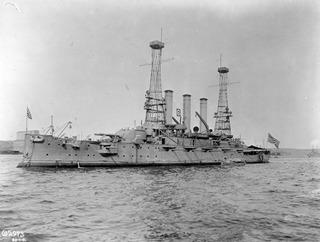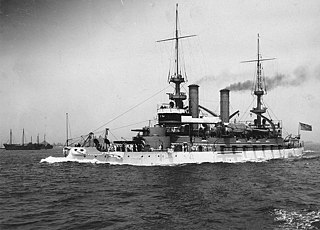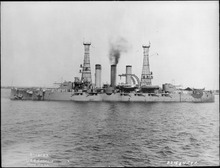
USS Delaware (BB-28) was a dreadnought battleship of the United States Navy, the lead ship of her class. She was laid down at Newport News Shipbuilding in November 1907, launched in January 1909, and completed in April 1910. The sixth ship to be named for the First State, Delaware was armed with a main battery of ten 12-inch (305 mm) guns all on the centerline, making her the most powerful battleship in the world at the time of her construction. She was also the first battleship of the US Navy to be capable of steaming at full speed for 24 continuous hours without suffering a breakdown.

USS Louisiana (BB-19) was a Connecticut-class battleship of the United States Navy. She was the second member of the class of six pre-dreadnought battleships, and the third ship to carry her name. Louisiana was laid down in February 1903, launched in August 1904, and commissioned in June 1906. She was a 16,000-long-ton (16,000 t) battleship capable of 19 knots. Her main armament consisted of four 12-inch (305 mm) guns supported by a mixed secondary battery of 7 in (178 mm) and 8 in (203 mm) guns.

USS Alabama (BB-8) was an Illinois-class pre-dreadnought battleship built for the United States Navy. She was the second ship of her class, and the second to carry her name. Her keel was laid down in December 1896 at the William Cramp & Sons shipyard, and she was launched in May 1898. She was commissioned into the fleet in October 1900. The ship was armed with a main battery of four 13-inch (330 mm) guns and she had a top speed of 16 knots.

USS Nebraska (BB-14) was a Virginia-class pre-dreadnought battleship of the United States Navy, the second of five members of the class, and the first ship to carry her name. She was built by the Moran Brothers shipyard in Seattle, Washington, with her keel-laying in July 1902 and her launching in October 1904. The completed ship was commissioned into the US Navy in July 1907. The ship was armed with an offensive battery of four 12-inch (305 mm) guns and eight 8-inch (203 mm) guns, and she was capable of a top speed of 19 knots.

USS Maine (BB-10), the lead ship of her class of pre-dreadnought battleships, was the second ship of the United States Navy to be named in honor of the 23rd state. Maine was laid down in February 1899 at the William Cramp & Sons shipyard in Philadelphia. She was launched in July 1901 and commissioned into the fleet in December 1902. She was armed with a main battery of four 12-inch (305 mm) guns and could steam at a top speed of 18 knots.

USS New Jersey (BB-16) was the fourth of five Virginia-class battleships of the United States Navy, and the first ship to carry her name. She was laid down at the Fore River Shipbuilding Company in Quincy, Massachusetts, in May 1902, launched in November 1904, and commissioned into the fleet in May 1906. The ship was armed with an offensive battery of four 12-inch (305 mm) guns and eight 8-inch (203 mm) guns, and she was capable of a top speed of 19 knots.

USS Virginia (BB-13) was a United States Navy pre-dreadnought battleship, the lead ship of her class. She was the fifth ship to carry her name. Virginia was laid down in May 1902 at the Newport News Shipbuilding and Dry Dock Company in Newport News, Virginia, was launched in April 1904, and was commissioned into the fleet in May 1906. The ship was armed with an offensive battery of four 12-inch (305 mm) guns and eight 8-inch (203 mm) guns, and she was capable of a top speed of 19 knots.

USS Kentucky (BB-6), was the second and final Kearsarge-class pre-dreadnought battleship built for the United States Navy in the 1890s. Designed for coastal defense, the Kearsarge-class battleships had a low freeboard and heavy armor. The ships carried an armament of four 13-inch (330 mm) and four 8-inch (203 mm) guns in an unusual two-story turret arrangement. The Newport News Shipbuilding Company of Virginia laid down her keel on 30 June 1896. She was launched on 24 March 1898 and was commissioned on 15 May 1900.

USS Ohio (BB-12), a Maine-class pre-dreadnought battleship, was the third ship of her class and the third ship of the United States Navy to be named for the 17th state. She was laid down at the Union Iron Works shipyard in San Francisco in April 1899, was launched in May 1901, and was commissioned into the fleet in October 1904. She was armed with a main battery of four 12-inch (305 mm) guns and could steam at a top speed of 18 knots.

USS Illinois (BB-7) was a pre-dreadnought battleship built for the United States Navy. She was the lead ship of the Illinois class, and was the second ship of the U.S. Navy to be named for the 21st state. Her keel was laid down in February 1897 at the Newport News Shipbuilding & Dry Dock Company, and she was launched in October 1898. She was commissioned in September 1901. The ship was armed with a main battery of four 13-inch (330 mm) guns and she had a top speed of 16 knots.

USS Rhode Island (BB-17) was the last of five Virginia-class battleships built for the United States Navy, and was the second ship to carry her name. She was laid down in May 1902, launched in May 1904, and commissioned into the Atlantic Fleet in February 1906. The ship was armed with an offensive battery of four 12-inch (305 mm) guns and eight 8-inch (203 mm) guns, and she was capable of a top speed of 19 knots.

USS Wisconsin (BB-9), an Illinois-class pre-dreadnought battleship, was the first ship of the United States Navy to be named for the 30th state. She was the third and final member of her class to be built. Her keel was laid down in February 1897 at the Union Iron Works in San Francisco, and she was launched in November 1898. The completed ship was commissioned into the fleet in February 1901. The ship was armed with a main battery of four 13-inch (330 mm) guns and she had a top speed of 16 knots.

USS Connecticut (BB-18), the fourth United States Navy ship to be named after the state of Connecticut, was the lead ship of her class of six pre-dreadnought battleships. Her keel was laid on 10 March 1903; launched on 29 September 1904, Connecticut was commissioned on 29 September 1906, as the most advanced ship in the US Navy.

USS Minnesota (BB-22), the fifth of six Connecticut-class pre-dreadnought battleships, was the first ship of the United States Navy in honor of the 32nd state. She was laid down at the Newport News Shipbuilding Company of Newport News, Virginia in October 1903, launched in April 1905, and commissioned into the US fleet in March 1907, just four months after the revolutionary British battleship HMS Dreadnought entered service. Minnesota was armed with a main battery of four 12-inch (305 mm) guns and a secondary battery of twenty 7 and 8 in guns, unlike Dreadnought, which carried an all-big-gun armament that rendered ships like Minnesota obsolescent.

USS Missouri (BB-11), a Maine-class battleship, was the second ship of her class and of the United States Navy to be named in honor of the 24th state. Missouri was laid down in February 1900 at the Newport News Shipbuilding & Drydock Company, was launched in December 1901, and was commissioned into the fleet in December 1903. She was armed with a main battery of four 12-inch (305 mm) guns and could steam at a top speed of 18 knots.

USS Kansas (BB-21) was a US Connecticut-class pre-dreadnought battleship, the fourth of six ships in the class. She was the second ship of the United States Navy named Kansas, but the only one named in honor of the state of Kansas. The ship was launched in August 1905 and commissioned into the fleet in April 1907. Kansas was armed with a main battery of four 12-inch (305 mm) guns and was capable of a top speed of 18 kn.

USS Vermont (BB-20), a Connecticut-class battleship, was the second ship of the United States Navy named after the 14th state. She was the third member of the class, which included five other ships. The Connecticut-class ships were armed with a main battery of four 12-inch (305 mm) guns and had a top speed of 19 knots. Vermont was laid down in May 1904 at the Fore River shipyard and launched in August 1905. The ship entered service with the Atlantic Fleet in March 1907.

The Kearsarge-class was a group of two pre-dreadnought battleships built for the United States Navy in the 1890s. The two ships—USS Kearsarge and USS Kentucky—represented a compromise between two preceding battleship designs, the low-freeboard Indiana class and the high-freeboard USS Iowa, though their design also incorporated several improvements. Their primary advances over earlier designs consisted of new quick-firing guns and improved armor protection, but their most novel feature was their two-story gun turrets that consisted of a secondary 8-inch (203 mm) gun turret fixed to the top of their primary 13-inch (330 mm) turrets. The ships suffered from a number of problems, however, including a tertiary battery mounted too low in the hull and poorly-designed turrets, though the latter were attempted again with the Virginia class in the early 1900s, also with negative results.

The Virginia class of pre-dreadnought battleships were built for the United States Navy in the early 1900s. The class comprised five ships: Virginia, Nebraska, Georgia, New Jersey, and Rhode Island. The ships carried a mixed-caliber offensive battery of four 12-inch (305 mm) and eight 8-inch (203 mm) guns; these were mounted in an uncommon arrangement, with four of the 8-inch guns placed atop the 12-inch turrets. The arrangement proved to be a failure, as the 8-inch guns could not be fired independently of the 12-inch guns without interfering with them. Additionally, by the time the Virginias entered service, the first "all-big-gun" battleships—including the British HMS Dreadnought—were nearing completion, which would render mixed battery ships like the Virginia class obsolete.

The Connecticut class of pre-dreadnought battleships were the penultimate class of the type built for the United States Navy. The class comprised six ships: Connecticut, Louisiana, Vermont, Kansas, Minnesota, and New Hampshire, which were built between 1903 and 1908. The ships were armed with a mixed offensive battery of 12-inch (305 mm), 8-inch (203 mm), and 7-inch (178 mm) guns. This arrangement was rendered obsolete by the advent of all-big-gun battleships like the British HMS Dreadnought, which was completed before most of the Connecticuts entered service.
























